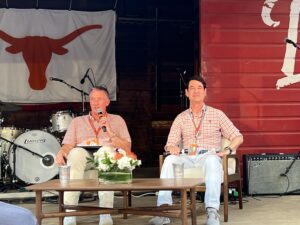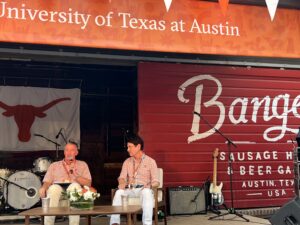As great as Austin’s trajectory has been, the best is yet to come.
That’s the gist of the conversation between Jay Hartzell, president of the University of Texas at Austin, and Jim Breyer, founder, and CEO of Breyer Capital. They participated in a fireside chat on “Building a Hub of Academic & Business Innovation at South By Southwest Saturday at Banger’s Sausage House and Beer Garden on Rainey Street.
Breyer called Hartzell one of “the great presidents of a university, if not the best president of a university in the United States.”
“I have never seen a leader doing so many tactical and strategic things for the university, the city of Autin, and the state of Texas,” Breyer said.
In the movie, The Graduate, the advice given to Dustin Hoffman’s character, Benjamin Braddock, is the future is plastics. Breyer referenced the movie when giving his advice.
“My advice to all of you….study linear algebra,” Breyer told the crowd. Linear algebra is the base of quantum technology, he said. Breyer is bullish on quantum but thinks the technology is still five to ten years away.
Breyer also encouraged interdisciplinary thinking between mathematicians, technologists, healthcare researchers, and more. Breyer said his mother, Eva, was a brilliant mathematician from Budapest, Hungary. His mother and father migrated to the United States, and his mother turned down a fellowship at Stanford to follow his father, who received a fellowship at Yale. Breyer was born in New Haven, Connecticut. He got his undergraduate degree from Stanford and his MBA from Harvard. As a venture capitalist, he was an early investor in Facebook, now known as Meta. He has also invested in Etsy, Spotify, and Grammarly.
About 15 years ago, Breyer began focusing on med-tech startups that use computational and artificial intelligence focused on medicine. He works with the best medical institutions to spin out startups. The first one Paige.Ai spun out of Memorial Sloan Kettering Cancer Center. It uses artificial intelligence for cancer diagnosis and treatment. The next spinout was from the University of Texas MD Anderson Cancer Center. So far, Breyer Capital has made ten similar investments.
Breyer said a lot is happening with artificial intelligence and proprietary data at hospitals and universities. It starts with a great medical team and a license with the hospital or cancer center. Breyer said his job is to find the brilliant 30 to 40 men and women to form the startup. He said those employees are mid-career technologists who come from other technology companies like Apple, Alphabet, and Amazon.
“I’m always working on one or two of these,” Breyer said. “That’s what brings me here today.”
Breyer and his wife, Angela Chao, moved to Austin from California three and a half years ago. He had been on the board of Dell and spent years traveling to Austin. Michael and Susan Dell are dear friends, he said. They encouraged them to move, and they finally did.
“We’re here forever,” Breyer said. “We love Austin, and we love the Hill Country.”
Since opening Breyer Capital’s Austin office, the firm has invested in many Austin-based startups, including OJO Labs, Sana Benefits, Homeward, DISCO, data.world, ZenBusiness, and ClosedLoop.ai.
Breyer said many universities are really siloed and don’t communicate well among the various departments.
“What Jay and the University of Texas are doing is breaking down many of those siloes,” Breyer said. “It takes leadership to break down those silos.”
Breyer pointed to the recent hiring of Dr. Claudia Lucchinetti as the next Dean of the Dell Medical School at UT Austin as a positive move to encourage more collaborations. Lucchinetti previously worked at Mayo Clinic in Rochester, Minnesota.
Not having a medical school for 100 years, Hartzell said UT doesn’t have to break down silos.
“They can build it in a way that is collaborative,” Hartzel said. “A lot of the university’s strengths are around robotics, AI, and technology. How do we get companies connected with us and find ways to work with us?
That means engaging with companies that want to hire students or that have a problem they want UT students and faculty to solve, Hartzell said.
“Universities don’t’ understand how daunting and complex it is for companies to build relationships,” Breyer said.
Breyer said he’s never seen it work with just a research person in charge of licensing technology.
“Innovation, entrepreneurship, the natural partnerships don’t happen,” Breyer said. “It comes down to the leadership, faculty, and post-docs. It’s happening here in Austin the way it doesn’t happen in other places.”
Hartzell asked Breyer what UT could do to support those collaborations.
Breyer said that UT Austin could continue attracting phenomenal talent, building affordable housing, and working hard to find intersection points. He said the idea is to get collisions between brilliant people to develop new ideas. Proximity and location are essential to make that happen, Breyer said. It’s important to have centers of excellence together.
“Not everyone needs to be around Austin, Texas downtown,” Breyer said.
Breyer suggested UT create a quantum-oriented center about 30 minutes from downtown, and he mentioned Stanford Research Parc in Palo Alto as a model. Breyer advised UT to own the land, and Hartzell agreed.
Another strength is Austin’s close proximity to San Antonio, Houston, and Dallas-Fort Worth, where phenomenal hospitals and educational institutions exist, Breyer said
MD Anderson sends data to our data scientists to build a model of a person to predict how the treatment is going to go, Breyer said.
“I truly believe in this area of AI and medicine,” Breyer said. “With the use of technology, we are making humans smarter.”
One-third of prostate and breast cancer diagnoses are incorrect, Breyer said.
“With technology, I’ve seen the cycle move from 10 days to two days, and the accuracy is 95 percent,’ Breyer said.


